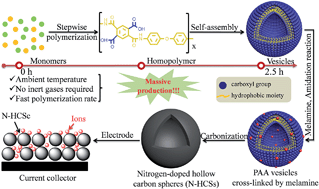Template-free fabrication of nitrogen-doped hollow carbon spheres for high-performance supercapacitors based on a scalable homopolymer vesicle†
Abstract
Presented in this article is the template-free fabrication of nitrogen-doped hollow carbon spheres (N-HCSs) as electrode materials for high-performance supercapacitors based on scalable homopolymer vesicles, which are self-assembled from an amphiphilic homopolymer, poly(amic acid) (PAA). This homopolymer can be massively produced by simple stepwise polymerization at room temperature with a fast polymerization rate. For the first time, PAA homopolymer vesicles are carbonized to form N-HCSs with tunable porous structures and nitrogen contents (from 1.3% to 7.4%) by controlling the content of the cross-linker (melamine). This template-free method for fabricating N-HCSs is more environmentally friendly and does not involve tedious synthetic procedures compared to traditional template-based methods. More importantly, the N-HCSs exhibit excellent electrochemical performance with a very high specific capacitance (266.9 F g−1) after more than 1000 cycles when used as the active electrode material for the supercapacitor. The N-HCSs presented in this paper retain its specific capacitance as high as 84% at a very high current density (20 A g−1). Given the potential massive production and excellent electrochemical properties, the N-HCSs based on the carbonization of scalable PAA homopolymer vesicles are promising candidate electrode materials for energy storage devices.


 Please wait while we load your content...
Please wait while we load your content...